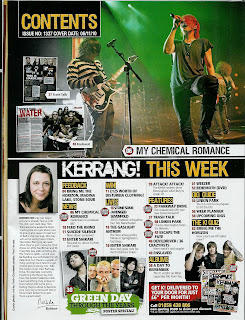Front cover
As my target audience is 16-24 I have used a young women who is in this age range for my main feature.
As she is the main feature of the magazine I have her on the front cover, in the middle of the page, and layered above everything else. Like Kerrang I have used an almost in your face image in colour. I have edited it using photoshop to make it very dramatic.
Again like Kerrang, I have used the wripped effect to give it a bit of a daring effect.
Like any other magazine I have included a line at the bottom of the page which almost gives the front cover a border. This line shows all the artists at the bottom of the page to look as if the the magazine is jam packed full of features.
I have used a common technique of adding a circle of information which looks like a stamp. It looks almost as if it was the last feature to be put in the magazine. I have used very common house colours of red, black and white, but have also added parts of grey.
Contents page
My contents page is quite organised but also messy at the same time. The text is in colums to make it easy to read, and colour coordinated to make it easy to understand. Like every other contents page I have seen the majority of it is pictures, although it is the page that needs to hold the most information.
I have used large, different coloured numbers in order to stand out and make it easy to interpretate where each feature is.

I have included an editors post just like kerrang so that the audience can feel as though they personally know who this person is. It makes the magazine almost 'homely' and recognisable if the same person is editing it every time and having their own view on this months magazine.
I have very clear captions on each photo used on the contents page like all other music magazines so that it is clear to the audience about what each picture tells you.
I have kept with the house colours, and also style of font throughout.
Double page spread

For my double page spread I haven't kept it very traditional in that it isn't really a picture, then an article but they are both merged into one. I have used just one, main image and then layered the text on top. The difference between my double page spread and main stream ones is that my article is very long compared to most.
It is very rare to do a question and answer interview, and it has been mentioned that NME have done this before. Personally I find it easier to read question and answer rather than a big long paragraph of text and I personally think that the majority of people aged 16-24 would. I have used a common technique that is taking pictures of the artist in a photoshoot rather than live images. I have done this to represent real intensity of the article. I would like people to feel as if they know her personally and not just someone who sings.


















































